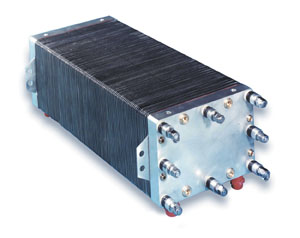Experimental Power System Expands Flight Capabilities
Fuel cells may one day be used to power small surveillance unmanned aerial vehicles (UAVs). Fuel-cell-powered UAVs could support longer missions than current power alternatives allow.
Benchmark tests pave way for longer surveillance missions. 
Photograph courtesy of European Communities.
Recent flights of the Spider-Lion fuel-cell-powered unmanned aerial vehicle have shed light on the potential for deploying fuel-cell technologies in the future. Researchers at the U.S. Naval Research Laboratory designed the Spider-Lion, and while the aircraft itself is not intended as a tactical device, it will serve as a high-impact research platform for testing fuel-cell technology. The two successful flights mark the first time a fuel-cell-powered unmanned aerial vehicle has flown for several hours.
Using a fuel cell instead of a battery on a small aircraft—under about 10 pounds—enables longer flight times and greater distance coverage. The U.S. Naval Research Laboratory (NRL),
“We’re not replacing a technology; we’re offering a new technology,” says Karen Swider-Lyons, head of the alternative energy section, chemistry division, NRL, and program manager for the Spider-Lion project. “Batteries can go only so far .... The hydrogen [fuel] cells are a way to go beyond that,” Swider-Lyons says.
Fuel cells offer several advantages over traditional power sources. For example, enemies have more difficulty detecting a fuel-cell-powered UAV than one powered by a small engine because the fuel cell system produces little noise and emits less infrared energy.
Ease of use is another advantage. Fuel cell systems start up immediately and are more efficient than combustion engines. A major significance of the Spider-Lion flights is the development of a reliable fuel cell system. Swider-Lyons says the teams could fly the UAV every day because it runs so well. “It’s quite an engineering feat to build a high-performance fuel cell that performs reliably,” she explains.
During the Spider-Lion’s inaugural flight, the aircraft flew for one hour and 43 minutes on half a tank of hydrogen fuel. The UAV’s second flight took place at the L-3/ BAI Aerosystems’ Ragged Island Flight Operations facility on
Swider-Lyon’s colleague James Kellogg, a research engineer for the tactical electronic warfare division at the NRL, led the team that built the UAV for the fuel cell system developed by Swider-Lyon’s team. The result was a 5.7-pound aircraft with a wingspan of 7.2 feet.
The reliability of the fuel cell is another important factor. A test done by other commercial companies in 2003 reported 15 minutes of flight over three attempts with a fuel cell integrated into a 15-inch vehicle.
The Spider-Lion project team purchased the fuel cell from Protonex Technology Corporation,
Swider-Lyons, Kellogg and their two teams worked closely in designing and redesigning the fuel cell system and UAV. They determined the power of the fuel cell, the size of the airplane and then how to make a fuel cell system light enough and small enough to fit in the UAV. The fuel cell had to be a self-contained system, and Swider-Lyons, Kellogg and their teams developed several prototypes of the fuel-cell-powered UAV before the vehicle was ready.
 |
| More reliable and quieter than combustion engines, a fuel-cell-powered small UAV would be harder to detect by enemy systems. |
The data gathered during the testing of the Spider-Lion will aid further research in developing a lighter fuel cell and larger UAV platform. However, current technology does not provide for a system that could power a large UAV or other aircraft with a fuel cell, and neither Swider-Lyons nor Kellogg expects that large UAVs or other aircraft will be powered by a fuel cell system.
The research team has not conducted cost-analysis to determine whether a fuel cell system has cost-savings benefits over combustion engines, but Swider-Lyons says that industry’s interest in the production of fuel cells is increasing and as the product is developed more, the price of fuel cells will decrease. The automotive industry is pursuing research for fuel-cell-powered automobiles, and the technology they develop could be applied to aircraft.
However, Kellogg points out that designing a system for a ground vehicle is easier than developing a system for an aircraft because excessive weight prevents an aircraft from flying.
Because the fuel cell project does not have a specific deadline for completion, it is not clear when such capabilities will be available for tactical missions. The NRL has been working on the project for approximately two years, but not aggressively. The next step in the development process will be researching different programs. Swider-Lyons says several organizations have expressed interest in this technology, but she cannot specify which groups at this stage of development. The absence of a specific time line gives the research teams flexibility in their scheduling and testing.
Web Resources
Protonex Technology Corporation: www.protonex.com
AeroVironment’s Hornet: www.aerovironment.cn/news/news-archive/hornet62.html



